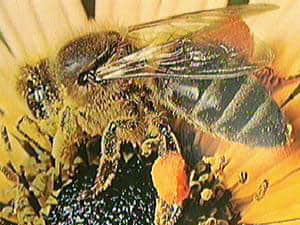Now that the “Killer Bees” are established here in San Diego County, finding a swarm or established nest of bees on your property may raise some questions, and maybe some concerns.
The Escondido Fire Department offers the following information in order to help you know what to do, what not to do, and who to call, in order to reduce the chances of becoming involved in a stinging incident.
Bee Basics
Africanized Honey Bees look just like the European Honey Bees we’ve always seen visiting the flowers in our gardens. They function and behave similarly, too, but the Africanized Honey Bee is much more protective of its home.
Just like the European Honey Bee, each Africanized Honey Bee can only sting once and then it dies. Also, the venom in either single sting isn’t a problem unless the victim is allergic. The difference is that Africanized Honey Bees are more easily disturbed and respond more quickly, stinging in greater numbers, and taking more time to calm down.
Like European Honey Bees, Africanized Honey Bees forage for water, pollen and nectar wherever they can find it and will visit our gardens to do so. They are not likely to attack unless they are disturbed. Left alone, they will pollinate your flowers and then return to their nests without any problems.
Swarming
Also like the European Honey Bees, Africanized Honey Bees swarm. This simply means that a colony has become overcrowded and it’s time for many of the bees to leave. They take off together in a group, technically a “swarm,” in order to establish a new home.
While a large mass of bees, buzzing through the air may seem threatening, it’s not interested in attacking anyone; its only purpose is to establish a new home. A swarm will often find a place to rest, in the branch of a tree or other comfortable spot, for a day or two, and then it will usually move on.
If the swarm is left alone, it is not especially dangerous, but do not attempt to move or destroy it yourself and, if possible, stay out of the immediate area. You may need to close your windows and stay inside. If avoiding the area is impossible, you may wish to contact a professional to remove the bees, even before giving them a chance to move on by themselves.
If bees come indoors, turn out the lights so that the bees will be attracted to the windows. If possible, open the window or door closest to them to let them out.




















